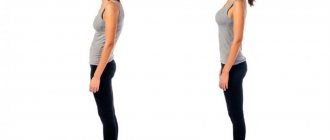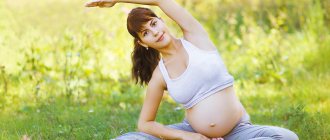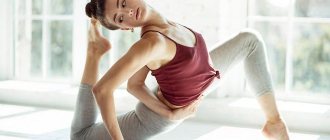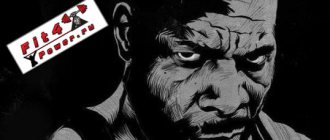Many people believe that old age and physical activity are incompatible concepts, because older people find it difficult to exercise due to chronic diseases and reduced resistance to exercise. This is partly true, but this is the main task of physical education - to strengthen the body and improve health. Therefore, fitness for the elderly is the right path to active aging.
Fitness for the elderly: goals and objectives
The main goal of playing sports for pensioners is to maintain health, the ability to move and self-care until old age. Fitness brings older people closer to this goal, as it allows them to solve a whole range of problems:
- Accelerate metabolic and energy processes;
- Strengthen the muscle corset, increase the elasticity of the ligamentous apparatus;
- Slow down the progression of osteoporosis;
- Tone the body;
- Reduce pain syndrome;
- Improve coordination of movements;
- Train the cardiovascular and respiratory systems;
- Stabilize digestive processes;
- Lose weight;
- Maintain clarity of mind for a long time;
- Stimulate immune defense;
- Normalize the psycho-emotional state.
Thus, fitness not only improves muscle strength, but also benefits the brain and psyche. For depression, group exercises are especially useful, as they expand a person’s social circle and distract from unpleasant thoughts.
Wall push-ups
This simple exercise effectively works the muscles of the arms, shoulders, and chest and does not require special training or equipment. Wall push-ups should be included in the daily gymnastics routine for retirees.
- What to cook from minced chicken
- 6 signs indicating a blood clot in the legs
- From August, Russian drivers will begin to use new license plates
Technique:
- Stand at arm's length from a wall without paintings, mirrors, or other decorative items.
- Lean forward slightly, press your palms to the support at shoulder height and width.
- Slowly bend your elbows and lean toward the wall. The torso should be slightly tense during the exercise so as not to bend, but to remain straight.
- Leaning forward as much as possible, gradually straighten your arms until you find yourself in a standing position. Repeat 10-20 times.
Difficulties in fitness after 60
Of course, as people age, they accumulate health problems that make any sports training difficult. The main difficulties include:
- Difficulty maintaining balance. Combined with osteoporosis, this increases the risk of falls and injuries;
- Changes in blood pressure, the appearance of shortness of breath due to physical activity;
- Increased pain in joints and muscles;
- Difficulty in selecting an adequate set of exercises;
- Inability to exercise regularly, breaks in training due to deteriorating health;
- Psychological barrier. Sometimes it is difficult for older people to start exercising because of fears and thoughts that all this is useless. This is especially true for beginners who have not played sports before.
All of the above difficulties are completely surmountable. Even if the patient is limited in movement outside the apartment or his own bed, this is not a reason for a complete refusal to exercise. Simple exercises are available to people who are bedridden or wheelchair-bound.
Information!
According to the WHO classification, people aged 60 to 75 years are considered elderly. After 75, old age begins. There are no age restrictions for physical training. Their program, frequency and duration are determined only by the state of health.
Stretching before exercise
Exercise for older people should begin with stretching exercises. They not only warm up the muscles, but also prepare the joints for further stress, and restore the mobility and flexibility of the ligaments lost with age.
Before starting to stretch, the athlete should spend 5-10 minutes. cardio loads.
It could be:
- jogging at a slow pace in the fresh air;
- walking in place at an average pace;
- riding a bicycle or exercise bike;
- swing your arms at a fast pace.
When doing stretching, you need to feel the measure. After the initial set of exercises, an elderly person should achieve a feeling of maximum stretching of the muscle corset without pain and discomfort. Otherwise, the athlete risks injury to joints, tendons, and causing sprains or tears in ligaments.
The most effective exercises for the introductory complex are:
| Exercise | Scheme of its implementation |
| Neck stretch | 1. Sit on a chair, resting your straight back on the supporting part of the structure. Leave your arms along the body in a free position. Bend your knees at an angle of 90 degrees and place them close to each other. 2. Slowly tilt your head forward, avoiding sudden movements. 3. Having reached the limit point, fix the position for 10 seconds. 4. Slowly, without pausing in the starting position, move your head back. 5. Save the position for 10 seconds. After completing the required number of repetitions of steps 2 - 5, you should tilt your head to the right - to the left, taking the above algorithm as the basis of the technique. |
| Hand stretching | 1. Clench your hands into fists as tightly as possible. 2. Relax the wrist muscles. 3. Alternately bend and straighten each finger on both hands. 4. Straighten the brush. Without using your other fingers, move your thumb as far away from your palm as possible. 5. Press your thumb into your palm. 6. Repeat steps 1 – 5 at least 10 times. |
| Leg stretching | 1. Sit on a chair. Place your feet on your heels. Squeeze your toes as tightly as possible. Fix them in this position for 10 seconds. Slowly release. 2. Perform circular rotations alternately with the right and left feet in the air, periodically changing the direction of their movement. 3. Raise your right leg, bend it at the knee and pull it towards you. Relax your muscles. Repeat with the left leg. 4. Bend your leg at the knee. Without changing the bend angle, raise the limb as high as possible from the floor, while remaining in a sitting position. Repeat with the other leg. |
Types of fitness for those over 60
The fitness program for older people is not limited to the standard set of exercises within the framework of exercise therapy. Other types of physical training are available to them:
- Walking. This could be Nordic walking, a health path or regular walking. Even a completely unathletic, untrained person can do them.
- Water aerobics. Gymnastics in the pool is the best option for patients with pathology of the leg joints and reduced muscle tone. Since body weight decreases in water, performing gymnastic elements becomes much easier.
- Exercises in the gym. Depending on the presence of chronic diseases, elderly patients can be offered a choice of exercise equipment such as a stepper, treadmill, elliptical, or exercise bike.
- Eastern practices - yoga, qigong, tai chi. They help improve breathing efficiency, increase musculoskeletal flexibility, and improve balance.
If the patient does not leave the apartment, then from the listed methods, oriental practices and training on some simulators are quite accessible to him, if it is possible to purchase them.
LiveInternetLiveInternet
Tuesday, March 07, 2020 07:15 + to quote book
The long-awaited spring has arrived, summer is coming and everyone wants to look beautiful. Some people go to the gym, others go on a diet. And someone works out on a simulator at home. But what if you don’t like monotonous workouts? And it’s so difficult to follow a diet... Zumba is ideal for such people. The founder of this wonderful movement is the Colombian choreographer Alberto Perez. He developed dance-type workouts. You are required to actively repeat incendiary movements after the trainer. The program includes rhythms of salsa and merengue, samba, flamenco. Don't think that you need to have dancing talent to practice. The main thing is to catch the rhythm, how beautiful your movements are is not important. After all, you don’t have to dance on stage. It should be noted that Zumba is an ideal workout option for those who do not like the boring and monotonous performance of regular exercises. Zumba for older people. Part 1. Zumba for older people. Part 2. Salsa. Zumba Gold - lightweight dance fitness for:
- older people - those who are contraindicated for intense exercise - those recovering from injury or childbirth
Zumba lesson for beginners.
The video shows a Zumba fitness dance lesson for beginners.
It tells about the origin of Zumba dance, its differences from other types of fitness and similarities with them. This type of fitness is remarkable because it can be done at any age and with different health conditions. Both advanced and beginners will burn calories and lose weight with this dance equally effectively. It has no contraindications, so almost everyone can use it for weight loss. For weight loss, Zumba is no less effective than any other types of group classes, but at the same time, the dance classes themselves are much more fun and do not burden the central nervous system. You can perform the proposed Zumba dance movements both to the music played in the lesson, and to the music of salsa, merengue, reggaeton, rumba, mamba, etc. If your goal is to lose weight, then this means you need to move for a long time.
The lesson lasts about an hour.
And believe me, during this time you will lose seven sweats. Zumba class is a fitness program for weight loss.
This is an energetic workout program that will keep you busy. And most importantly, she won’t get tired of it. Since “dance for weight loss,” as Zumba is also called, has many variations. You can learn new movements and combine them. Overall a fun workout. Zumba will help you stay fit and put you in a good mood. Source Zumba for older people, for those who have never done physical activity. Video lessons for weight loss and good mood. Part 2. Watch here. Zumba is for older people, for those who have never done physical activity. Video lessons for weight loss and good mood. Part 3. Watch here. Zumba is for older people, for those who have never done physical activity. Video lessons for weight loss and good mood. Part 4. Watch here.
Series of messages “different dances”:
Part 1 - a 70-year-old woman dances with her 29-year-old grandson. Part 2 - Beautiful dance. ... Part 14 - Tomoko, pole dancing at 70 years old. Part 15 - Very beautiful dance: Flame of love. Video. Part 16 - Zumba for older people, for those who have never done physical activity. Video lessons for weight loss and good mood. Part 1. Part 17 - Dance show on the Russia-1 TV channel: “Everyone is dancing!” First issue dated March 19, 2017. Video. Part 18 - Dance show on the Russia-1 TV channel: “Everyone is dancing!” Issue 2 dated March 26, 2017. Video. ... Part 33 - Zumba for older people, for those who have never done physical activity. Video lessons for weight loss and good mood. Part 4. Part 34 - Music from films that won millions of hearts. Video. Part 35 - The legendary dance of Patrick Swayze. Video.
| Categories: | • dance • health |
Cited 360 times Liked by: 99 users
Like share
0
Like
- 99
I liked the post - 360
Quoted - 3
Saved
- 360
Add to quote book - 3
Save to links
Liked99
0
Rules for performing physical exercises
In order for the training to bring only benefits, you need to follow the basic rules of playing sports in old age:
- When planning classes, focus on the state of your body. For example, in case of severe osteoarthritis of the hip joints, loads on the lower extremities are contraindicated, and in case of coronary heart disease, active cardio training is contraindicated;
- Start practicing with the simplest exercises, repeating them only 3-4 times;
- It is better to train 1-2 times a day. This can be a morning warm-up and the main gymnastic complex, which is performed in the late afternoon - at 16-18 hours;
- Start exercising no earlier than an hour after eating;
- Monitor your condition - monitor your blood pressure and pulse, take note of any dizziness, pain, or severe shortness of breath. If your health worsens, you need to take a rest break and reduce the intensity of your activities;
- Exercise with caution. If necessary, hold on to the support, avoid jerking movements and rapid lifting of weights;
- Don't limit the amount of fluid you drink. During classes, you are allowed to drink in small sips, because some of the water from the body is lost through sweat.
Helpful advice!
Before starting training, be sure to visit the clinic. It is necessary to examine a therapist, and sometimes specialists of a narrow profile - a neurologist, orthopedist, ophthalmologist, cardiologist. After the doctors make a conclusion, contact a physical therapy doctor, he will help you create an adequate fitness program taking into account all the identified diseases.
Physical exercises for older people and its principles
Exercise for an elderly person will only be a joy when two principles apply. Firstly, those exercises were selected that will only bring benefits, and this was confirmed by the attending physician. Secondly, you cannot force an elderly person to do physical exercises. The desire should come from himself, and the movement should bring joy.
So, we start by telling and showing the elderly person all the exercises, not forgetting to simply and clearly explain what their benefits are. Make the number of repetitions of the exercises and their load uniform, the same, but keep in mind that its increase should take into account the strength of the elderly patient.
If possible, the exercise should take into account all parts of the body that are not affected by disease. If an exercise is uncomfortable for an elderly person and causes pain, then it should be replaced with a more gentle one. When performing a complex of physical exercises for older people after 60 years of age, it would be reasonable to have an instructor or a caring relative nearby. Carefully observe the condition of the elderly person, his reaction, and positive attitude towards activities. Let's remember:
- If you notice that while doing exercises, he is tired, does the exercises with force, or suddenly his mood has deteriorated, then the exercises should be stopped.
- Exercises that the patient performs himself will be called active; exercises will be called passive if you help an elderly person do it, raise his arms, turn him over, shake him, rub him.
- Don’t overdo it with time, 10-20 minutes is enough!
- During physical exercises of an elderly person, watch his breathing: inhale spontaneously, calmly, exhale more deeply, without straining. The movements are smooth, at a calm pace. It is better to place a pillow under the head of a lying elderly person so as not to provoke a rush of blood to the head.
- If an elderly person likes morning exercises, then you can increase the number of easy exercises and reduce the number of difficult ones. Perform repetitions wisely, start with two repetitions, gradually increase to eight. Left-right exercises should be the same.
- It is no coincidence that exercise is called morning exercise, since the most effective exercises are in the morning, before breakfast, in a pleasant, cool room. It is better to start charging with a calm walk, and if the size of the room does not allow, then on the spot. In between exercises, it is good to walk around the room.
A set of exercises for the elderly
Fitness training for an elderly person should include working out all muscle groups, strength and cardio training, and tasks to maintain balance. Let's give an example of exercises for patients in the 60+ group.
- We consistently perform smooth turns and tilts of the head in different directions.
- Rotate your head clockwise and counterclockwise.
- We place our bent arms in front of the chest - hands at the level of the shoulder joints. Rotate your forearms in and out.
- We straighten our arms, carry out rotational movements in the shoulder joints, first forward, then back.
- We place our palms on the waist, bend and turn the body in different directions.
- We rotate our torso to the right - to the left, bending only at the lumbar spine.
- From a standing position with your hands on your belt and your feet shoulder-width apart, do squats. If it is difficult to do such an exercise without support, then you are allowed to hold on to the back of the chair.
- Still holding onto the support, we perform swings alternately with the right and left legs forward, backward, and to the side.
- We sit on the floor, join our legs and stretch them forward. We reach with outstretched arms and body towards our toes.
- In the same position, we spread our legs to the sides, trying to reach the right and left toes alternately.
- We lie down on our backs. Raise your straight legs up. First alternately, then both at once.
- We pull the bent legs towards the stomach and straighten them again.
- Bend your knees and pull your feet closer to your pelvis. Raise your buttocks, resting only on your feet and shoulders.
- We roll over onto our stomachs. We clasp the hands behind the back, at the level of the buttocks. We bend back, pulling our head towards the ceiling. At this moment, the arms straighten and stretch back.
General rules and weekly lesson plan
Drinking still water little by little during training is not only possible, but necessary.
Weekly preventive and health training for an elderly man should include the following types of exercises and activities:
- Morning exercises . Exercises must be done daily. The main purpose of exercise is to smoothly wake up the body, and not to train it. Therefore, it includes simple general developmental exercises for all joints, performed at a slow to medium pace. Its duration should be short - 10-15 minutes.
- A set of exercises for older men should consist of 2 parts : exercises with dumbbells or on weight machines + cyclic cardio exercise, which can be obtained on a rowing, skiing or exercise bike, stepper or during Nordic walking with poles. This lesson should take place either 2-3 times a week, or every other day. Exercising more often is not advisable and can be harmful. Between strength exercises and cardio training, you can take a short break to rest and change into a different sports uniform. The load and duration increases gradually.
- Other days of the week should be devoted to sports games depending on your mood. The list of “useful” games for older men is quite extensive:
- tennis, table tennis, badminton;
- billiards;
- bowling;
- petanque, towns;
- cricket, golf;
- darts, archery, other types of sports shooting.
- Evening cool down . The duration of the selection of stretching exercises, which should be performed shortly before going to bed, should be the same as morning exercises - no more than 15 minutes. You can do this complex every other day, but it’s better daily. These exercises will help improve the quality of sleep, reduce strength and reduce the number of night cramps, and ease joint stiffness.
Advice. Don’t just forget, but be sure to include “mental exercise” – intellectual board and computer games – in your weekly physical education plan. It is also shown to play music, sing, write poetry, draw and engage in other types of artistic creativity. A separate line is ballroom dancing. If you have a partner for this, do not neglect this type of physical activity that is difficult to coordinate.
An example of morning exercises for older men
There are quite a few varieties of morning hygienic exercises for older men. For those who love variety, this could be a monthly alternation of selections from ordinary general developmental exercises, which, by the way, can be performed even while lying in bed, a series of yoga asanas, or complexes of health-improving oriental practices of wushu, tai chi or qigong.
“Eye of Rebirth” is a Sufi whirling + 4 dynamic asanas from Hatha yoga
For those older men who are not afraid of monotony and want to get a powerful effect of healing and rejuvenation, we recommend doing Tibetan lama gymnastics or 5 magical rituals (pearls) described in Peter Kalder’s book “The Eye of Renaissance” as morning exercises.
The main rules of the “Eye of Rebirth” system that require strict adherence:
- You need to exercise daily.
- It is important to follow breathing instructions during exercise.
- For beginners, it is permissible to violate the technique of performing rituals. However, if you want to get the maximum effects from the “Eye of Rebirth”, learn to perform the exercises strictly according to the description and original author’s pictures.
- The tempo-rhythm of execution should be slow and smooth, without pauses between repetitions of movements. But between exercises you can and should rest.
- The load should be increased gradually - starting with 3 repetitions of each of the five exercises (rituals, pearls), adding 2 repetitions every week.
- The maximum number of repetitions of rituals is 21 times.
- If there was a break, for example, due to illness, then the practice begins from the very beginning - with 3 repetitions of each pearl (+ 2 every week).
- Take a hygienic shower or hardening douches before (!) performing the exercises, and after, if necessary, you can wipe yourself with a warm, damp towel.
- For those who have “reached the ceiling,” you can either start additionally practicing “Eye” in the evening, or find on the Internet a diagram of special meditative breathing by chakras, which is performed during each of the rituals.
It is better to exercise at dawn, ideally in the fresh air. Dress code is loose, barefoot. To practice, you will need a flat place and a mat. Calm music or sounds of nature are welcome.
Before performing exercises, do a short joint warm-up. Do each of the circular movements shown in the figure below in the indicated sequence, 6-8 times in each direction (outward and inward, or clockwise and counterclockwise).
Basic vortex joint warm-up
| Image and title | Brief instructions |
| Stand up straight, spread your arms to the sides. Make non-stop clockwise rotations. For starters, this is 3 turns. After stopping, if you feel dizzy, do some breathing exercises and wait until the dizziness goes away. |
| Starting position (IP): lying on your back, palms near your hips resting on the floor, toes pulled towards you. 1. As you begin to inhale, first pull your chin toward your sternum. 2. Continuing to inhale, raise your legs to a 90-degree angle. Please note that the feet are pulled towards themselves. 3. As you exhale, simultaneously and slowly place your head and legs on the floor, in I.P. To begin with, if it is difficult, you can raise your legs with your knees bent. |
| The starting position is quite uncomfortable, but it should be taken correctly. On your knees, bring your ankles together and place your toes on the floor. Place your palms under your buttocks. The chin touches the sternum. The back is straight. 1. As you inhale, pull your chin up, bending your chest slightly and spreading your elbows back. Don't arch at the waist. 2. As you exhale, return to the starting position. |
| IP: basic sit, legs together, toes pulled towards you, palms resting on the floor on either side of the hip joints, chin touching the sternum, back straight. 1. As you begin to inhale, tilt your head back. 2. Continuing to inhale, lift your pelvis up. The line of the spine and hips should be straight and parallel to the floor, and the arms and shins should be vertical. 3. Exhaling, return to I.P. |
| IP: lying position, straight legs connected and not touching the floor, palms resting on the floor in the projection of the hip joints so that the arms are perpendicular to the floor, head thrown back. 1. As you inhale, lift your pelvis up. Ideally, your legs should be straight, your heels should be on the floor, your chin should be touching your chest, and your spine and arms should be arched. 2. As you exhale, return to IP without lowering your hips to the floor. |
Attention! We would like to warn you about the consequences that await people who decide to quit working on the “Eye of Rebirth”. For several weeks, your health will sharply deteriorate, your performance will decrease, and chronic pathologies may worsen.
A set of strength exercises
For those older men who do not have the opportunity to visit the gym, we have prepared a selection of videos with dumbbell exercises that can be performed at home. Select the optimal weight of dumbbells individually, but for this age category it is recommended to work with weights of 1.5-2 kg.
Before performing a strength set of exercises with dumbbells, do not forget to do a whirlwind warm-up of the joints, and then several exercises from the school physical education program - bending to the side, twisting, lunges, squats. There is no need to repeat each movement many times. 6-8 times will be enough.
Keeping in mind that after the strength training, cardio training awaits you, start with strength exercises for the legs, then work on the abs and back. Let us remind you that to begin with, each of the exercises should be performed at a slow pace - lift the weight on a count of 2 or 3, and lower it in the same amount of time.
At each end point of the movement you need to pause for 1-1.5 seconds. At the same time, do one approach of the maximum number of repetitions for you - until there is slight discomfort or pain in the muscles. Between exercises, take rest breaks, during which you do not forget to drink some warm drinking water without gas.
Attention! For those who have problems with the lumbar region, it is better not to perform exercises in a standing position, the name of which contains the phrases “deadlift” or “bent over row”.
Now start working on the shoulder girdle and chest. Here is a video of exercises with dumbbells for retirees that will help maintain tone and strengthen the strength of the muscles of the upper body, and, if performed correctly and dosage, increase their volume.
When can you move on to 2 and 3 approaches of performing one exercise in a row, while slightly reducing the number of repetitions? This depends on your initial physical fitness and general health, but in any case you should not rush. It is better to increase the loads of dumbbell gymnastics with temporary gaps of 1.5-2 months.
After resting a little, change clothes, take a flask of water and go for a walk in the fresh air with special walking sticks.
Nordic walking
The best type of cardio training for older men, especially for those who are just starting to engage in health-improving physical education, is Nordic (Finnish) walking with poles.
It has a number of advantages over other cyclic types of loads:
- all-season - you can walk at any time of the year and in any weather;
- all-terrain - you can walk on asphalt, cinder or dirt surfaces, on grass, but it is better to practice away from highways, and start walking on rough terrain only after 2-3 months of training;
- no monthly subscription fee is required to visit the gym or purchase expensive home exercise equipment;
- special poles are affordable, you can buy them in sports stores and on the Internet (it is better to buy telescopic models that allow you to precisely adjust their length to your height);
- the use of sticks protects against accidental falls, and also engages the joints of the arms, muscles serving the shoulder girdle and deep postural muscles of the back.
On a note. Compared to regular walking, Nordic walking increases physical activity by 15%, while smoothly redistributing it between all parts of the body, and unlike jogging, it does not cause prolonged vertical shock to the spine and internal organs.
Correct walking technique and choosing the length of a pole
Before you start Nordic walking, take some time to learn the correct walking technique with poles.
Before you watch a short but very good video explanation on this topic, check out the common mistakes to avoid:
- simultaneous forward extension of “one-sided” arms and legs;
- bringing the leg forward and placing the foot flat;
- sluggish, unaccented pushing off with the foot of the leg located behind, without actively bending it and raising the heel high;
- raising the “front” hand too high;
- placing the stick vertically or throwing its lower end forward before pushing off;
- at the moment when the hand is behind, the hand continues to squeeze the handle;
- too wide stance of legs and arms.
It is worth increasing the load gradually. To begin with, walk slowly, and it is better not to focus on the number of steps, but to dose the load over time. Start with a 7-10 minute walk, making sure that halfway through the walk you start walking in the opposite direction.
To control the required intensity of the load obtained during measured walking or on dynamic cardio equipment, periodically monitor your heart rate. Special heart rate monitor bracelets allow you to do this right on the go. If you don’t have such a gadget, it doesn’t matter. Stop and count the pulse on the carotid artery.
Keep your heart rate between 65 and 85 percent of your maximum. It is calculated using the formula: 205.8 - (0.685 * your age).
The recommended duration of Nordic walking after strength training is 20-30 minutes. After cardio training, when you come home or are in the gym, take your time to take a shower. Rest for 15-20 minutes.
An example of an evening cool-down routine for older men
Many older men neglect to do stretching exercises. Gerontologists recommend doing at least a little of this type of physical exercise.
The best time to do them is shortly before going to bed. Regular evening stretching in old age will help:
- remove congestion of skeletal muscles and maintain the tone of smooth (!) muscles;
- slow down aging (stiffness) of joints;
- reduce the rate of loss of elasticity of muscle fibers and ligaments;
- maintain the secretion of intra-articular synovial fluid;
- avoid the accumulation of lactic acid in muscle fibers, and therefore reduce the inevitable manifestations of soreness that occur after strength exercises with weights;
- eliminate insomnia, normalize the quality of sleep, reduce or completely get rid of night-time joint stiffness and muscle cramps.
On a note. Having problems with the prostate gland? Stretching exercises for the groin and hip joints are one of the forms of treatment and prevention of diseases of this organ.
A flexible spine and mobile joints are the key to healthy longevity.
Before you start doing stretching movements, be sure to warm up all joints using circular movements of a whirlwind warm-up.
Then perform each exercise, following these rules:
- unlike strength exercises, stretching exercises should not cause pain, on the contrary, they should bring pleasure;
- Do each stretch in 2 steps - hold the position with minimal stretching force for 10-15 seconds, then, simultaneously with a deep exhalation, slightly increase the stretch and hold it for another 10-15 seconds;
- perform exercises only in the specified sequence;
- during exercises, do not hold your breath or push - inhalations and exhalations should be rhythmic and superficial;
- if desired, each of the exercises can be repeated not 1, but 2 or 3 times;
- you shouldn’t be zealous; the main thing in stretching for older people is not the result, but the process itself.
Advice. To enhance the calming effect on the nervous system, practice while listening to melodic music or recordings of nature sounds.
Standing stretches
| Image and title | Brief instructions |
| 1. Gently tilt your head back and to the right side, increasing the stretch of the anterior neck muscles by pressing with your fingers. 2. Then tilt your head forward and to the left, helping yourself with your hand. Stretch your neck in two other directions - back and left, forward and right. 3. Having fixed the lower jaw with your left hand (a double chin should appear), stretch your neck upward with your right hand, grasping the back of your head. |
| 1. Place both palms (back to back) on your lower back. Bring your elbows back. 2. Stretch your left arm down and to the right, clasping your elbow with your right hand. 3. Now pull your elbow up and towards you to the right. Repeat step 1 and do stretches (2-3) for your right arm. |
| Also do this series of stretches in a row. First stretch the muscles on one arm, and then on the other. 1. Standing sideways to the wall, rest the palm of your “nearest” slightly bent arm against it. Stretch by turning away from the support. 2. In this position, the triceps are stretched. 3. Holding the door frame and leaning forward, we “work” with the biceps. |
| 1. When bending back, for safety reasons, place your feet shoulder-width apart. The stretching of the muscles of the shoulder girdle depends on how you hold your palms. Therefore, repeat the exercises several times, changing the position of your palms. Make sure your breathing is rhythmic. Breathe shallowly. 2. Stretch the lateral muscles of the torso by grasping the doorway, placing your legs almost flush against it. Don't forget to do the exercise in the other direction. |
| 1. Stand one step away from the wall. Standing on your right foot, place your left foot on your heel, resting its toe and palms on the wall. Push your pelvis forward without bending your knee or lifting your heel off the floor of your left leg. 2. Do a cross lunge (right leg supporting), helping with your hand resting on the wall. 3. Stand on your right knee so that all angles in the joints of your legs are straight. Tighten your buttocks and move your pelvis forward. Repeat all movements with the other leg. |
Morning exercises for older people
An active lifestyle and regular exercise contribute to longevity and good health. Exercising in the morning invigorates the body, improves the functioning of the heart and nervous system, and normalizes appetite and sleep. The pensioner gains muscles and straight posture, and begins to do more things during the day. Gymnastics is recommended even after a stroke, albeit in a simplified form.
They do the exercises in the morning, because at this time they bring maximum benefit, when the body has not yet expended energy on digesting food. The room should be ventilated and slightly cool. It is advisable to start training with a leisurely walk or step in place (in cramped conditions). During pauses between different exercises, you can walk around the room.
Recommended set of exercises:
- Warm up the cervical spine: tilt your head forward and down, alternately rotating it to the right and left, like a pendulum.
- We turn our heads to the right and left shoulders, after which we begin to reach for each shoulder.
- Rotate your head 4 turns in each direction.
- We put our hands on our shoulders and rotate them in a circle back and forth, repeating 6 times in each direction.
- We stretch our arms to the sides, bend them at the elbow joints and rotate them. Also 6 times in each direction.
- As we inhale, we spread our arms, and as we exhale, we bend forward. Then we get to the starting position and perform a deflection, spreading our arms to the sides.
- We perform half squats. Heels together, toes apart, hands on the belt. Squatting halfway, we spread our knees to the sides.
- We perform full squats while rotating our arms.
This kind of gymnastics for older people (you can watch the video at the link below) is traditional and suitable for all age groups.











